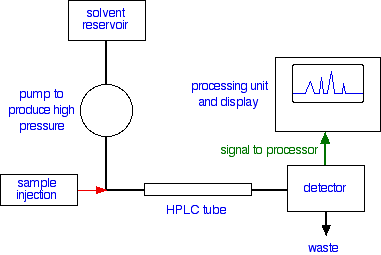High-performance liquid chromatography is a form of more advanced liquid chromatography that Joe uses commonly in the lab. He uses this method to separate compounds that are dissolved in a solution. With this, Joe can then figure out the chemical composition of the sample and if there are proper amounts of all the different compounds according to the formulations of the products.When the sample solution comes in contact with a particular solvent in liquid state, the different solutes in the solution interact with the solvent differently depending on several factors such as molecular size, absorption, ion-exchange, polarity, and more. These differences are what allow the components of the sample to be separated from each other. For instance, different polarities of the compounds in the solute (also depending on the polarity of the solvent) cause the different retention times, allowing the substances to be extracted and separated. This is due to "like dissolves like", causing polar to dissolve in polar, and non-polar to not dissolve in polar. Also, usually the smaller the molecular weight, the easier it is to travel through the solvent and therefore the difference in molecule sizes can cause separation.

What an HPLC instrument looks like.
HPLC works differently than traditional simple chromatography, since it uses an HPLC instrument that consists of a resevoir mobile phase, a pump, an injector, a separation column, and a detector. The compound is separated by injecting the sample onto the column. The different moleules and ions in the sample pass through the column of the solvent at different rates due to many factors and characteristics as mentioned in the above paragraph. Here is more on how the HPLC instrument works in detail:
The liquid sample is introduced into a "loop" with a syringe. The sample will then travel through the column (also known as the HPLC tube), and the time it takes for the compound to travel through the column to the detector is know as the
retention time. The retention time is based once again on characteristics like molecular size, polarity, temperature, etc. The substance will then reach the detector, and the detector detects the arrival of the substance with ultra-violet absorption. The UV detector reads how much light is absorbed by the chemical, and if it reads something, then that signifies the compound has passed through. The output is recorded as a series of peaks, and each peak represents a compound that was in the sample mixture. The peaks can be used to measure the quantity of the substances and determine more information.
Schematic of an HPLC instrument.


No comments:
Post a Comment